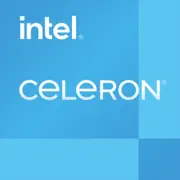Intel Celeron 7305

Intel Celeron 7305: A Budget Processor for Everyday Tasks. Full Review
March 2025
Introduction
Intel Celeron processors have always been associated with affordable laptops for basic tasks. However, with the release of the 12th generation (Alder Lake), the situation has changed: even budget chips have received modern technologies. The Celeron 7305 is a prime example of such an upgrade. In this article, we will explore who this processor is suitable for, how it handles work and multimedia, and whether it is worth considering in 2025.
Architecture and Technology Process: Hybrid Approach and Energy Efficiency
Heterogeneous Design: 5 Cores without Hyper-Threading
The Celeron 7305 is built on the Alder Lake hybrid architecture. Unlike the high-end Core i5/i7 processors, it uses a simplified configuration:
- 1 Performance-core (P-core) with Hyper-Threading disabled (operates at a frequency of up to 4.1 GHz in turbo mode);
- 4 Efficient-cores (E-cores) without Hyper-Threading (base frequency of 1.9 GHz, turbo up to 3.3 GHz).
In total: 5 physical cores and 5 threads. This approach optimizes power consumption but limits multitasking capabilities.
Intel 7 Technology Process: 10 nm with Enhanced Efficiency
The chip is manufactured based on Intel 7 (10 nm Enhanced SuperFin), providing:
- A reduction in power consumption by 15-20% compared to the previous generation (Jasper Lake);
- Support for DDR4-3200 / LPDDR5-4800;
- Integration of graphics Intel UHD Graphics (12th Gen) with 48 EU and a frequency of up to 1.3 GHz.
iGPU: Graphics for Office and Video
The integrated graphics card handles:
- Outputting images at 4K@60 Hz;
- Playing videos in AV1, VP9, H.265;
- Undemanding games (for example, Among Us or Dota 2 at low settings achieves 25-30 FPS).
Power Consumption and TDP: A Balance Between Power and Battery Life
The nominal TDP of the processor is 15 W, allowing it to be used in thin laptops without active cooling. However, under load, the chip can momentarily consume up to 25 W (in Turbo Boost mode).
Power-saving Technologies:
- Intel Dynamic Tuning 2.0 — automatically adjusts power based on load;
- Deep Learning Boost — accelerates AI tasks (such as noise reduction in Zoom);
- Speed Shift Mode — instant switching between processor states.
Performance: Tests in Real-World Scenarios
Office and Browsing
- Microsoft Office + 10 Chrome tabs: the processor does not overheat, no lags;
- Zoom Conference with Background Effect: load on E-cores, consumption is 8-10 W.
Multimedia
- Rendering a 10-minute video in 1080p (DaVinci Resolve): 12-15 minutes (for comparison, the Ryzen 3 7320U completes it in 8 minutes);
- Streaming 4K Video: hardware decoding is utilized by the iGPU, CPU load is 5-7%.
Gaming
- CS:GO (1280x720, low settings): 35-40 FPS;
- The Sims 4 (1366x768, medium settings): 45-50 FPS.
Turbo mode operates for up to 30 seconds at temperatures below 75°C. After that, the P-core frequency drops to 3.5 GHz.
Usage Scenarios: Who is the Celeron 7305 Suitable For?
- Students: working with texts, presentations, online courses;
- Office workers: email, Excel spreadsheets, video calls;
- Casual users: social media, streaming, light gaming.
Not Suitable For:
- Photographers/Videographers (slow rendering);
- Gamers (except for casual projects);
- Programmers working with code compilation.
Battery Life: How Long Will the Laptop Last?
With a battery capacity of 40-50 Wh (typical for budget models):
- Video streaming: 8-9 hours;
- Working in Chrome: 6-7 hours;
- Maximum load: 2-2.5 hours.
Tip: Choose laptops with LPDDR5 memory — it reduces overall power consumption by 10-15%.
Comparison with Competitors
AMD Ryzen 3 7420U (Zen 2, 4 Cores/8 Threads)
- Pros: better multitasking, Vega 5 graphics (20% faster);
- Cons: higher price (laptops from $450).
Apple M1 (7-core GPU)
- Pros: battery life up to 15 hours, high performance;
- Cons: macOS, cost starting from $800.
Intel Core i3-1215U (6 Cores/8 Threads)
- Pros: Hyper-Threading, turbo frequency up to 4.4 GHz;
- Cons: TDP 15-55 W, laptops from $550.
Conclusion: The Celeron 7305 is only advantageous in terms of price. For those who prioritize a budget under $400, there are almost no alternatives.
Pros and Cons of Celeron 7305
Strengths:
- Low cost of laptops ($300-450);
- Support for modern standards (Wi-Fi 6E, Thunderbolt 4);
- Sufficient performance for basic tasks.
Weaknesses:
- No support for Hyper-Threading;
- Weak iGPU for gaming;
- Limited multitasking capabilities.
Laptop Selection Recommendations
- Device Type: ultrabook or compact laptop with a 13-15 inch display.
- Essential Parameters:
- 8 GB RAM (preferably DDR5);
- 256 GB SSD (NVMe);
- Matte display with Full HD resolution.
- Additional Bonuses:
- USB-C with Power Delivery;
- Weight up to 1.5 kg.
Examples of 2025 Models:
- Lenovo IdeaPad Slim 3 15 ($349): 8 GB/256 GB, 15.6" IPS;
- HP 14-dk2000 ($399): 12 GB/512 GB, touchscreen.
Final Conclusion
The Intel Celeron 7305 is a great choice for those looking for an affordable laptop for everyday tasks. It provides smooth operation in office applications, adequate battery life, and support for modern interfaces. However, for professional tasks or gaming, it is better to consider models with Ryzen 3 or Core i3. If your budget is limited to $400, the Celeron 7305 will be a reliable companion for studying, working, and entertainment.
Basic
CPU Specifications
Memory Specifications
GPU Specifications
Miscellaneous
Benchmarks
Compared to Other CPU
Related CPU Comparisons
Share in social media
Or Link To Us
<a href="https://cputronic.com/en/cpu/intel-celeron-7305" target="_blank">Intel Celeron 7305</a>

